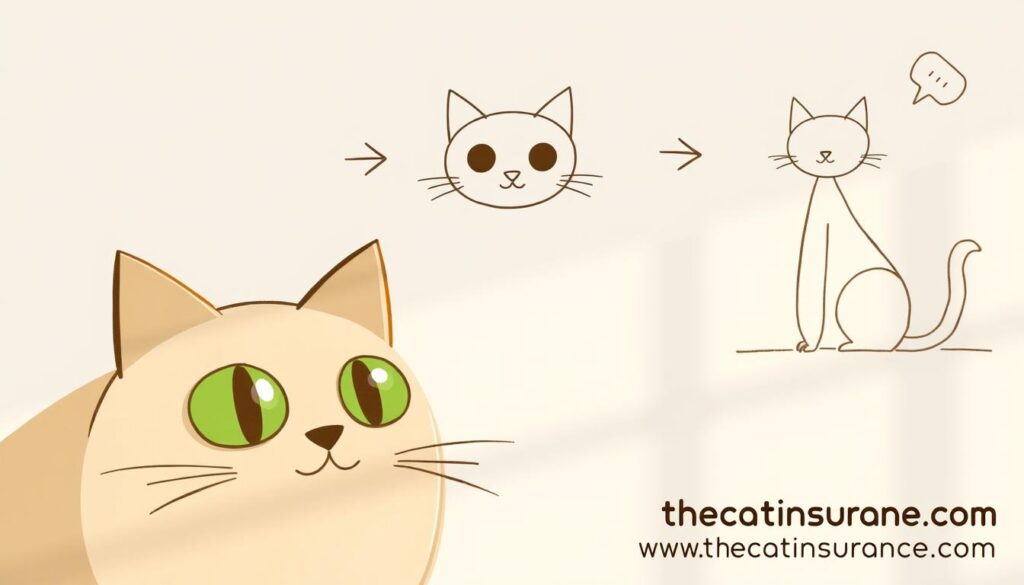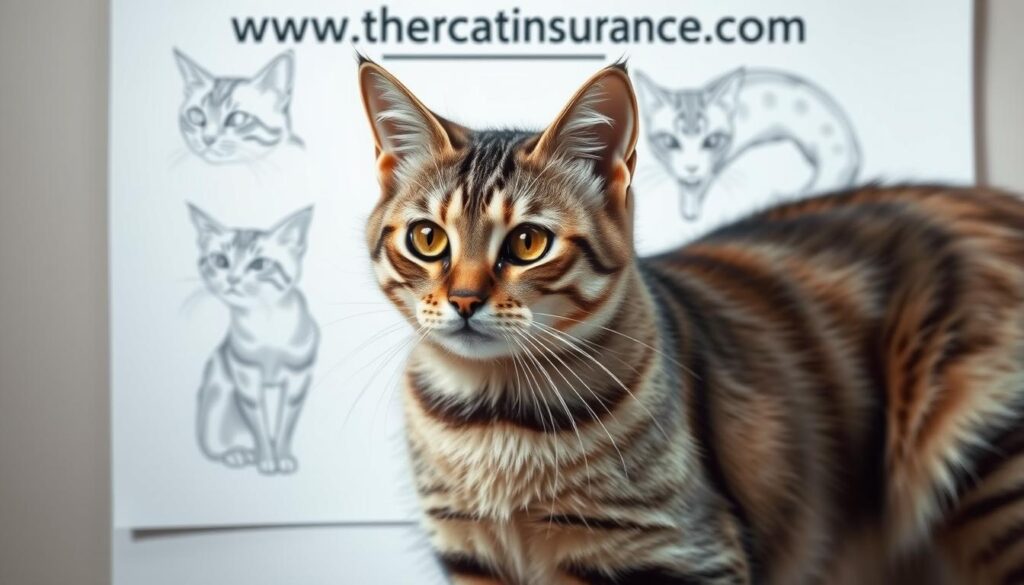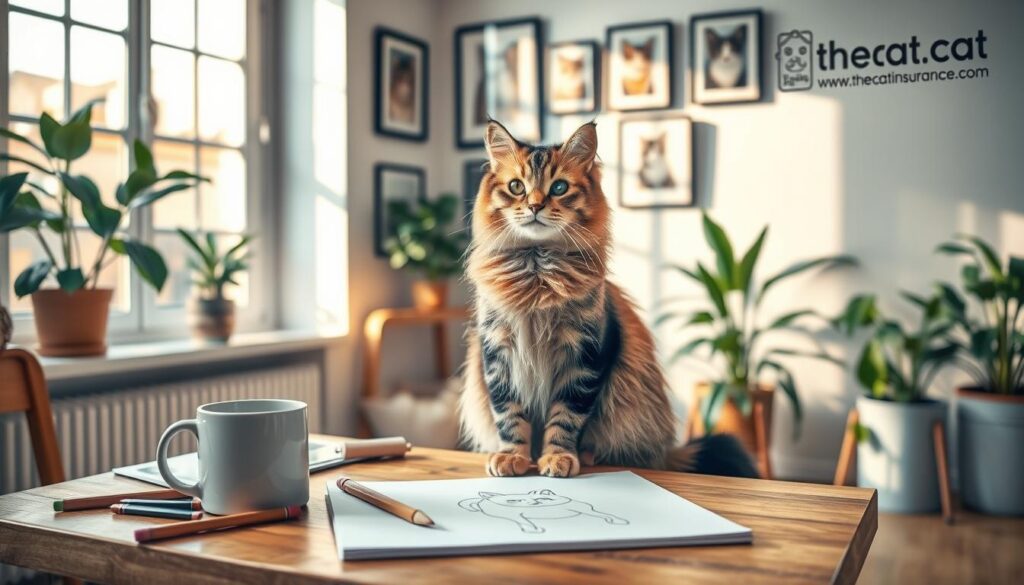How To Draw A Cat : Are you fascinated by the world of cat art? Drawing cats can be a fun and rewarding hobby. It lets you express your creativity and show your love for felines.
Whether you’re a complete beginner or looking to improve, this guide has got you covered. You’ll learn about cat anatomy, proportions, and shading. These skills will help you create beautiful and realistic cat drawings.
As a cat lover, you’ll enjoy capturing their unique personalities on paper. For more information on cat care and insurance, visit www.thecatinsurance.com.
Key Takeaways
- Learn the basics of cat anatomy and proportions
- Discover easy techniques for drawing cats
- Improve your shading and texture skills
- Create realistic and beautiful cat drawings
- Explore the world of cat art and express your creativity
The Growing Trend of Cat Art in 2023
In 2023, cat art has become very popular. Artists and cat lovers are both drawn to it. This is because more people have cats as pets and feel a strong bond with them.
Why Cat Drawing Has Become a Popular Hobby
Cat drawing is now a favorite hobby for many. It’s calming and lets people show off their creativity. Feline sketching tips and cat illustration techniques are shared online, encouraging others to create cat art.
- The pandemic led to more people getting pets, boosting cat art’s appeal.
- Instagram and TikTok are where cat artists show their work and find buyers.
- Digital tools make it easy for beginners to start drawing cats.
Recent Cat Art Exhibitions and Online Movements
In 2023, there were many cat art exhibitions online and offline. These events celebrate the creativity of cat-inspired art. Online forums for cat art have also grown, offering a place for artists to share, learn, and join cat art challenges.
As noted on www.thecatinsurance.com, cat art is more than just creating. It’s about building a community of cat lovers. This sense of community is key to cat art’s rising popularity.
Essential Supplies for Beginning Cat Artists
Starting your cat drawing journey? You’ll need the right tools to create beautiful art. For easy cat drawing, a few basic materials will help you bring your feline subjects to life.
Must-Have Materials for Your First Cat Sketches
For a step by step cat drawing tutorial, you’ll need some essentials. First, get a good quality sketchbook with a smooth finish. This lets your pencils move smoothly.
Next, get a set of graphite pencils (HB, 2B, 4B, 6B). They’re key for creating different shades and textures. Don’t forget an eraser, like a kneaded eraser, for fixing mistakes and adding highlights.
Budget-Friendly Options for Aspiring Artists
Following a cat drawing tutorial doesn’t have to cost a lot. Look for student-grade art supplies that are cheaper but still good quality. Buying sets or bundles can save you money.
Also, check out second-hand art stores or online marketplaces for used art supplies. This way, you can start creating stunning cat art without spending a lot.
Understanding Feline Anatomy: The Foundation of Good Cat Art
For artists wanting to get better at drawing cats, learning about feline anatomy is key. It’s important to know the structure of cats to make your art look realistic and engaging.
Key Proportions Every Cat Artist Should Know
To draw cats right, you must understand their basic shapes. A domestic cat’s body is usually 5-6 times longer than its head. The head is rounded, with eyes about one-third of the way down from the top. Knowing these shapes is vital forrealistic cat drawing tutorials.
How Domestic Cat Anatomy Varies by Breed
Domestic cats come in many breeds, each with its own body shape. For example, Maine Coons are big and broad-chested, while Siamese cats are slim and sleek. Learning about these differences can help you improve yourcat illustration techniques. For more info on cat breeds, check out www.thecatinsurance.com.
Resources from www.thecatinsurance.com on Cat Breeds
www.thecatinsurance.com has lots of info on cat breeds and their unique features. By using these resources, you can learn how to draw different breeds accurately. This will help you get better at yourfeline sketching tips.
By learning about feline anatomy and practicing, you’ll soon create amazing cat art. Your art will show off your knowledge of these amazing animals.
How to Draw a Cat Using Simple Shapes
Learning to draw a cat with simple shapes is great for all artists. It breaks down a cat’s complex form into basic shapes. This makes drawing a cat easier and more realistic.
The Circle and Oval Method for Basic Cat Forms
The circle and oval method is key for drawing cats. Begin with a big circle for the body and a smaller one for the head. Add an oval for the torso, linking it to the head and body circles. This setup helps you get the cat’s proportions and pose right.

As animal artist ” says, breaking down subjects into simple shapes leads to better drawings. This method helps artists capture the cat’s essence and details.
Transforming Geometric Shapes into Feline Figures
After setting up the basic shapes, refine them into a cat-like form. Add ears, legs, and a tail, using smooth curves and lines. Focus on the proportions to make your cat look natural.
| Shape | Body Part | Description |
|---|---|---|
| Large Circle | Body | Forms the main body of the cat |
| Smaller Circle | Head | Represents the cat’s head |
| Oval | Torso | Connects the head and body, forming the cat’s torso |
By following these steps and practicing, you’ll get good at drawing cats with simple shapes. Start with basic forms and add details to make your cat drawing realistic and engaging.
Mastering Cat Facial Features and Expressions
Drawing a cat’s face that shows emotion and character needs detail and practice. To make a realistic and engaging feline portrait, you must learn the subtleties of their facial features.
Techniques for Drawing Realistic Cat Eyes
Cat eyes are very expressive. Start by sketching the overall shape, noting they are different from human eyes. Use a gentle, curved line for the upper lid and a more angular line for the lower lid. The goal is to capture the shine and depth of the eyes.
- Observe the shape and size of the eyes in relation to the head.
- Pay attention to the color and texture of the iris.
- Highlight the eyes with a sharp, white point to give them a lively appearance.
Capturing the Unique Structure of Cat Noses and Mouths
The nose and mouth of a cat are subtle yet crucial. When drawing these features, remember the nose is small and the mouth is often a simple curved line. The key is to keep these features in proportion to the rest of the face.
Tips for drawing noses and mouths:
- Keep the nose small and slightly upturned.
- Use a gentle curve for the mouth, avoiding too much detail.
- Observe how the nose and mouth change with different expressions.
Creating Expressive Ears and Whiskers
Ears and whiskers are key for showing a cat’s mood and attitude. Ears can be positioned in various ways to indicate the cat’s emotional state. Whiskers add a dynamic element, suggesting movement and sensitivity.
To draw expressive ears and whiskers, focus on their positioning and flexibility. For ears, consider the angle and how it reflects the cat’s mood. For whiskers, capture their length and how they move around the cat’s face.
Step-by-Step Cat Drawing Tutorial for Complete Beginners
Learning to draw cats can be fun, especially with good guidance. This guide is for beginners. It teaches the basics of cat drawing in simple steps.
Drawing a Sitting Cat: From Outline to Details
To draw a sitting cat, start with basic shapes. Use a circle for the head and an oval for the body. Connect them with curves for the neck and back. Remember, the head should be about one-quarter the size of the body.
Next, add the legs and tail. The legs should be folded under the body. Use simple lines for the paws and tail. Then, add details like eyes, nose, mouth, and fur texture.
Creating a Cat in Profile View
Drawing a cat in profile needs attention to its anatomy. Start with an oval for the body and a smaller circle for the head. This view highlights the cat’s facial features and body structure.
Use a curved line for the back and another for the belly. Add the legs, making sure they’re right. The profile view is great for drawing the cat’s ears, eyes, and nose in detail.
Sketching a Sleeping Cat Position
A sleeping cat is serene and cute. Start by sketching the cat’s curled-up body. Use ovals and circles to outline the body and head.
Focus on the curled legs and tail wrapped around the body. Soft, gentle lines help show the cat’s relaxed state. Details like closed eyes and a peaceful expression make the drawing come alive.
| Cat Position | Key Features | Tips for Beginners |
|---|---|---|
| Sitting | Folded legs, visible facial features | Focus on proportions and gentle curves |
| Profile | Visible ear, detailed facial features | Practice drawing the cat’s anatomy |
| Sleeping | Curled-up body, relaxed expression | Use soft lines to convey relaxation |
By following these steps and practicing, you’ll get better at drawing cats. You’ll be able to capture their unique features.
Feline Sketching Tips from Professional Cat Illustrators
Professional cat illustrators share their top tips for creating stunning feline artwork. By learning from the experts, you can improve your cat drawing skills. You’ll also get insights into the latest trends in cat art.
Expert Advice from Today’s Leading Cat Artists
Leading cat artists stress the importance of understanding feline anatomy. Paying attention to the proportions and structure of your cat’s features is key. They also suggest practicing different poses and angles to capture the dynamic nature of cats.
| Tip | Description | Benefit |
|---|---|---|
| Study Feline Anatomy | Understand cat proportions and structure | More realistic drawings |
| Practice Various Poses | Draw cats from different angles | Captures dynamic feline movement |
| Use Reference Images | Reference real cats for accuracy | Improved detail and realism |
New Techniques Gaining Popularity in Cat Art Communities
New techniques are emerging in the cat art community. Artists are using digital tools to achieve hyper-realistic cat illustrations. They’re also experimenting with different mediums, like watercolor and mixed media, to create unique cat art pieces.
By incorporating these expert tips and new techniques into your cat drawing practice, you’ll be well on your way to creating beautiful and captivating feline artwork.
Easy Cat Drawing Techniques for Different Fur Types
Drawing cats is more than just their shape. It’s about getting their fur right too. To draw cats that look real, you need to know how to draw different fur types.
Cats come in many breeds, each with its own fur. From the smooth coats of short-haired cats to the long, fluffy fur of long-haired ones. Knowing these differences is crucial for drawing cats that look real.
Short-Haired Cat Texturing Methods
Short-haired cats have smooth fur. Use short, gentle strokes to show the fur’s direction and flow. Focus on where the fur lies flat, like the back and shoulders.
Creating Fluffy Long-Haired Cat Fur
Long-haired cats need a different touch. Use long, soft strokes to show their fluffy fur. Layering your pencil work can make it look three-dimensional.
Special Effects for Tabby Patterns and Markings
Tabby cats have special M-shaped markings and stripes. To draw these, notice how the markings stand out against the fur. Use different line weights and shading to get the details right.
| Fur Type | Drawing Technique | Effect |
|---|---|---|
| Short-Haired | Short, gentle strokes | Smooth, sleek texture |
| Long-Haired | Long, soft strokes, layering | Fluffy, voluminous texture |
| Tabby | Varying line weights, shading | Distinctive patterns and markings |
Learning these techniques will improve your easy cat drawing skills. You’ll be able to create more realistic and engaging cat art.

Realistic Cat Drawing Tutorial: Adding Depth and Dimension
Creating a realistic cat drawing is more than just sketching. It’s about adding depth and dimension. You need to focus on shading, creating highlights, and adding background elements.
Shading Techniques to Bring Your Cat to Life
Shading is key for a realistic cat drawing. It adds volume and depth. Use techniques like hatching and cross-hatching to create textures and tones.
Hatching involves lines that follow your subject’s contours. Cross-hatching adds layers for deeper tones.
Creating Highlights for Eyes and Fur
Highlights are vital for a cat’s eyes and fur. Use a sharp pencil or fine-tip pen for small, precise dots or lines. For eyes, focus on catchlights for a lively look. For fur, subtle highlights suggest texture and shine.
Background Elements That Enhance Your Cat Drawing
The background can make or break your cat drawing. Simple colors or gradients help your cat stand out. You can also add furniture or scenery for context.
Make sure the background doesn’t overpower the cat. Use soft colors, gentle textures, and subtle patterns for balance.
Mastering shading, highlights, and background elements improves your cat illustration techniques. You’ll create more realistic and engaging feline artwork.
Digital Cat Illustration Techniques Trending Now
Cat artists are now using digital tools to create amazing illustrations. The digital art world has opened up new possibilities. It allows for greater flexibility and creativity.
Popular Apps and Software for Modern Cat Artists
Several digital drawing apps and software are popular among cat artists. Some of the most widely used include:
- Adobe Photoshop
- Clip Studio Paint
- Procreate
- Krita
These tools offer a range of features. They can enhance your cat illustrations, from layer management to custom brush engines.
| Software | Key Features | Price |
|---|---|---|
| Adobe Photoshop | Advanced layer management, extensive brush library | $20.99/month |
| Clip Studio Paint | Tone curves, text layer support, comic-friendly features | $8.99/month |
| Procreate | High-performance brush engine, intuitive interface | $9.99 one-time purchase |
Digital Brushes That Simulate Cat Fur Textures
Simulating cat fur texture is key in digital cat illustration. Digital brushes can be customized for realistic fur effects. Some popular brush packs include:
- Fur texture brushes
- Whisker simulation brushes
- Claw detail brushes
From Traditional to Digital: Making the Transition
For artists switching from traditional to digital, learning the basics is crucial. This includes understanding the software, practicing with different brushes, and experimenting with layer management.
By making this transition, cat artists can expand their creative possibilities. They can produce high-quality digital art.
Cat Drawing Challenges and Events to Join This Year
The world of cat art is buzzing with new challenges and events. Whether you’re a seasoned artist or just starting out, these opportunities are great. They let you showcase your skills, learn from others, and keep up with the latest trends in feline art.
Online Communities Celebrating Feline Art
Online communities are key for cat artists to share their work and get feedback. Platforms like Instagram and Facebook host many groups for cat art. Artists can connect with each other and with potential buyers here.
Some popular online communities include Cat Art Club on Facebook and #catart on Instagram. These platforms are not just for showing off your work. They also offer chances for collaboration and learning.
Upcoming Cat Art Contests and Exhibitions
Several cat art contests and exhibitions are planned for this year. They offer artists a chance to gain recognition and exposure. For example, the annual Cat Art Exhibition in New York is a big event that draws artists from all over.
| Event | Date | Location |
|---|---|---|
| Cat Art Exhibition | March 15, 2024 | New York |
| Feline Art Contest | June 10, 2024 | Online |
| Whisker Wonders Art Show | September 20, 2024 | Los Angeles |
How Social Media Is Transforming Cat Art Sharing
Social media has changed how cat art is shared and seen. Artists can now reach people all over the world with just a few clicks. Platforms like TikTok and Instagram are key for finding new talent.
By using social media, cat artists can grow their following and connect with their audience. They can also keep up with the latest trends and challenges in the cat art world.
Conclusion: Continuing Your Cat Drawing Journey
Now that you’ve finished this guide on drawing cats, it’s time to practice. Drawing cats can be a fun hobby. With regular practice, you’ll get better at drawing cats.
Keep trying new techniques and styles as you draw more cats. Draw different breeds and explore textures and patterns. Try to capture the unique personalities of cats.
Join online communities or enter cat art contests to improve. This will keep you motivated and give you feedback and inspiration from other artists.
With patience, persistence, and dedication, you’ll soon make amazing cat drawings. So, get your pencils, paper, and art supplies ready. Let’s bring our feline friends to life through drawing.

